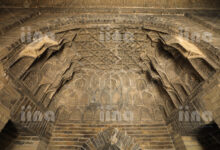The Abbasid Palace is recognised to be one of the most important heritage sites in Baghdad, located to the left bank of the Tigris River. It was built approximately between 1179 to 1225 AD by the Caliph Al-Nasser, which is towards the end of the Abbasid Dynasty. Entirely built with wood and bricks, the palace represents the rich art of ancient Islamic architecture. The structure was used as a madrasa, meaning school in Arabic, where it gathered scientists and intellectuals to exchange ideas and culture.

During the Abbasid Empire, new artistic techniques were evolving especially Islamic art. The technique consists of geometrical shapes, floral-like patterns, and calligraphy which also were greatly influenced by Sassanian Art. The Abbasid Palace is covered in geometrical carvings from the walls to the ceilings.

The pointed arches represent the multiple doors and windows of the palace, this can be seen in the courtyard which is surrounded by these majestic structures. The courtyard can lead to different rooms of the palace through those pointed arches.

The multiple arched columns inside the palace have unique carved ornaments through long corridors. The detailed floral patterns and clean cut of the bricks show the impressive talent and innovative minds of artists and architects of the Middle East. The Abbasid Palace portrayed the wealth of the Abbasid Caliphate as it became the Golden Age of Islam.
The palace stands in great preservation, inviting visitors to explore this rich heritage site.
- Published: 15ht March, 2024
- Date Taken: 13th March, 2024
- Location: Baghdad, Maidan Square
- Country: Iraq
- Editor: Elika Bozorgi
- Photographer: Firas Hamid Karim
- Category: Culture & Heritage

















